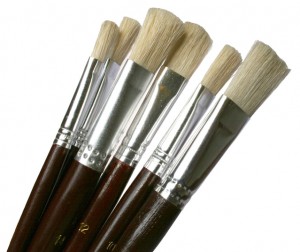Glass paint and paint brushes
The best paint brushes for glass paint
Beyond using good quality mohair paint brushes, there’s nothing special about your brush selection. You can use any cut and size – round, flat – whatever works for your project. You’ll want to avoid synthetic brushes – not because the brush can’t take the paint, but because it will be harder to clean the glass paint off of a synthetic brush than one made with natural hair.
To clean glass paint from a paint brush, you’ll want to use acetone. A brush with synthetic bristles may not stand up well to acetone. Likewise, if you’re not careful, a lower quality paint brush (one that is predominantly plastic) may be negatively affected by acetone as it evaporates.
If you have a larger surface area to cover, you can still use a paintbrush. Let the size of your glass determine the size of your brush. If you intend to use a larger paintbrush, you may want to condition the paintbrush by dipping the bristles into acetone and allowing it to dry. Submerge the brush all the way to the ferrule and allow the paintbrush to dry naturally. Conditioning the brush prior to use will make it easier to clean the brush after you’ve finished painting.
Once you are ready to paint, remember to dip your paintbrush into the paint no more than about one-third to one-half of the way to the ferrule. This will help prevent the brush from being overloaded with paint, and will help you maintain good control over the amount of paint you’re working with at any given time.
You’ll want to use at least three coats of paint when working with glass. When working with a brush, you need to be mindful of the amount of paint you apply to each coat. Thicker coats will take longer to dry. Thinner coats will allow you to achieve more consistent coverage over a large piece of glass.
If you’d like more information about working with glass paint, or you’d like to order glass paint online, please visit our online store.
Photo Credit: Pascal Thauvin, via FreeImages.com

